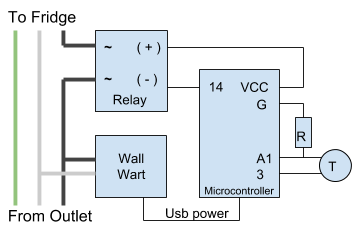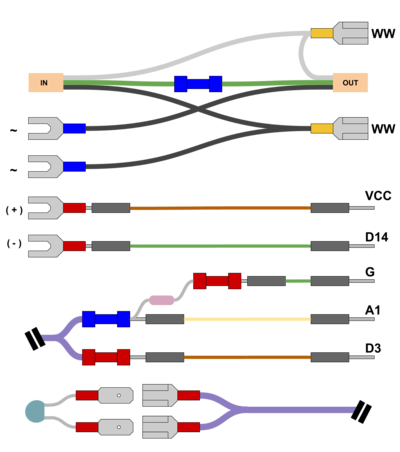Freezer to Refrigerator Conversion: Difference between revisions
| Line 112: | Line 112: | ||
{{Hint|The trigger values below did not work. See [[Talk:Freezer to Refrigerator Conversion]]. Try 298 and 301}} | {{Hint|The trigger values below did not work. See [[Talk:Freezer to Refrigerator Conversion]]. Try 298 and 301}} | ||
Code history - [[File:fridge_code. | Code history - [[File:fridge_code.rtf]] | ||
<nowiki> | <nowiki> | ||
Revision as of 01:56, 12 March 2019
Introduction
Convert a freezer to a refrigerator, and reduce energy consumption 12x so that your refrigerator uses 8 Watts of average power.
This translates to about 50 million megawatt hours of electricity (126M households with 1 fridge) saved per year in the USA if everyone converted to an energy saving fridge from a 1kWhr/day scenario today. This is about $5 billion dollars saved per year in America.
Nearly every household on Earth has a verticaldoor fridge that uses 100W of power on average - or about 2.4 kWh per day. In a country of a few million households, replacing vertical door refrigerators with chestfridges can save enough energy to allow closing down at least one large power station. Alternatively, construction of a new power station to meet the increasing energy demand could be avoided or delayed. http://mtbest.net/chest_fridge.html
In money terms, the Superfridge costs 2 cents per day to run (assuming 10 vent per kWh electricity cost). This is about $7 per year - compared to $88 for an average fridge.
For the Seed Eco-Home, the cost is actually even better. The off-grid energy system cost $3000 for 3kW not including labor. This translates to 2 cents per kWh energy cost over a 20 year life of the PV system. That is about $1.50 electricity cost to run the refrigerator for a whole year!
Original Work
This work is based on the Mt_Best_Freezer_to_Refrigerator_Conversion.
Wiring Diagram
Wiring Harness
BOM
![]() Hint: Transition to Arduino Nano, which is less expensive and appears not to need special libraries to run like the Sparkfun Pro Micro
Hint: Transition to Arduino Nano, which is less expensive and appears not to need special libraries to run like the Sparkfun Pro Micro
Bill of Materials' lists all parts required to build a machine.
amazon
- Sparkfun Pro Micro 3V amazon
- or adafruit Trinket amazon
- Relay amazon
- Themister amazon $4.32
- 10K resistor amazon
- Female Headers amazon
- Jumper Wires M/M amazon
- USB Wall Charger 1A 5V amazon
- 6" USB Cable amazon
- 4"x4"x2" Electrical Junction Box amazon amazon
- 1-11/16 Hole Saw amazon
- Extension Cord amazon
- 2 Conductor Wire amazon
- Crimp Connection Assortment amazon amazon
sparkfun
- Sparkfun Pro Micro 3V - $19.95 sparkfun - Install Instructions
- Arduino MKR1000 WIFI sparkfun
- 24-280VAC Relay - $9.95sparkfun
- or SainSmart Relay Module $3.99 - Requires 5V Board
- Thermister $0.75
- 10k Resistor $0.95
- Female Headers
- Jumper Wires M/M
- USB 5V Charger $3.95
- USB Micro Cable $1.95
- Junction Box $7.23
- Extension Cord - Ace Hardware
- 2 Conductor Speaker Wire - Ace Hardware
- Crimp Connections
Luxury Edition
- 120V Male Receptical amazon
- 120V Female Receptical amazon
- Hole Saw 1-11/16" amazon
- MKR1000 amazon
- Illuminated Plug Extension Cord amazon
- 6x6x4 Junction Box amazon
- potentiometer adafruit grainger
Tools
- step drill bit amazon
- drill
- butt connector crimper amazon
- small blade screw driver
- phillips head screw driver
- soldering iron - for adding headers amazon
- solder amazon
- electrical tape ace
Arduino Code
![]() Hint: Sparkfun Pro Micro controller appears to require Arduino IDE v1.0.1. Not. See installation notes at https://learn.sparkfun.com/tutorials/pro-micro--fio-v3-hookup-guide/installing-mac--linux
Hint: Sparkfun Pro Micro controller appears to require Arduino IDE v1.0.1. Not. See installation notes at https://learn.sparkfun.com/tutorials/pro-micro--fio-v3-hookup-guide/installing-mac--linux
![]() Hint: The trigger values below did not work. See Talk:Freezer to Refrigerator Conversion. Try 298 and 301
Hint: The trigger values below did not work. See Talk:Freezer to Refrigerator Conversion. Try 298 and 301
Code history - File:Fridge code.rtf
//A1 read voltage
//D3 sensor power
//D14 relay (-)
volatile int sensorvalue = 328; //define the variable
int triggeron = 328; //number that will trigger fridge on
int triggeroff = 304; //number that will trigger fridge off
// the setup function only runs once every time the chip is reset
void setup() {
digitalWrite(3, HIGH); //for powering thermister
digitalWrite(14, HIGH); //for switching relay
pinMode(3, OUTPUT); //begin operating pin
pinMode(14, OUTPUT); //begin operating pin
delay(20000); // wait for thermister to get a good initial reading
}
// the loop function runs over and over again forever
void loop() {
sensorvalue = analogRead(A1); //read sensor
if (sensorvalue > triggeron){ //if sensor reads over triggeron, turn on
digitalWrite(14, LOW); //turn on relay
delay(8000); //wait 8 seconds
}
if (triggeroff > sensorvalue){ //if sensor reads below triggeroff, turn off
digitalWrite(14, HIGH); //turn off relay
delay(8000); //wait 8 seconds
}
}
- See Talk:Freezer to Refrigerator Conversion for explination of trigger values.
Other Options
- http://mikeysklar.blogspot.com/p/yatc.html
- https://www.amazon.com/gp/product/B0002EAL58
- https://johnlvs2run.wordpress.com/2009/10/08/chest-fridge-conversion/

